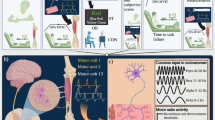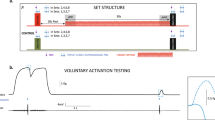Abstract
Physiological fatigue, a loss of maximal force producing capacity, may originate both from changes at the peripheral and at the central level. The readiness potential (RP) provides a measure to study adaptations to physiological fatigue at the motor cortex. We have studied the RP in the course of repetitive contractions at a high force level. Fourteen female healthy subjects made repetitive force grip contractions at 70% of their maximal voluntary contraction (MVC) for 30 min. Contractions were self-paced and inter-squeeze interval was about 7 s. During the repetitive contractions, the area under the curve of the RP almost doubled at electrode Cz and increased fourfold at electrodes C3′ and C4′. The onset of negativity moved forward from 1.5 to 1.9 s before force onset at Cz and from 1.0 to 1.6 s and 1.7 s before force onset at C3′ and C4′, respectively. EMG amplitude and median frequency did not change significantly and MVC after the fatiguing exercise was 93% of MVC before, indicating relatively little physiological fatigue. The increase of the RP during the repetitive contractions is clearly in excess of the almost absent signs of peripheral fatigue. Because the increase of the RP does not lead to an increased force production, we propose that it is a central adaptation counteracting the decrease of cortical efficiency during repetitive contractions.


Similar content being viewed by others
References
Becker W, Kristeva R (1980) Cerebral potentials prior to various force deployments. Prog Brain Res 54:189–194
Bigland-Ritchie B, Jones DA, Hosking GP, Edwards RH (1978) Central and peripheral fatigue in sustained maximum voluntary contractions of human quadriceps muscle. Clin Sci Mol Med 54:609–614
Brunia CHM, van Boxtel GJM, Speelman JD (2004) The bilateral origin of movement-related potentials preceding unilateral actions. J Psychophysiol 18:140–148
Danion F, Latash ML, Li ZM, Zatsiorsky VM. (2000) The effect of fatigue on multifinger co-ordination in force production tasks in humans. J Physiol 523:523–532
Deecke L (1996) Planning, preparation, execution, and imagery of volitional action. Brain Res Cogn Brain Res 3:59–64
Deecke L, Scheid P, Kornhuber HH (1969) Distribution of readiness potential, pre-motion positivity, and motor potential of the human cerebral cortex preceding voluntary finger movements. Exp Brain Res 7:158–168
Freude G, Ullsperger P (1987) Changes in Bereitschaftspotential during fatiguing and non-fatiguing hand movements. Eur J Appl Physiol Occup Physiol 56:105–108
Gandevia SC (2001) Spinal and supraspinal factors in human muscle fatigue. Physiol Rev 81:1725–1789
Gandevia SC, Allen GM, Butler JE, Taylor JL (1996) Supraspinal factors in human muscle fatigue: evidence for suboptimal output from the motor cortex. J Physiol 490:529–536
Hunter SK, Lepers R, MacGillis CJ, Enoka RM (2003) Activation among the elbow flexor muscles differs when maintaining arm position during a fatiguing contraction. J Appl Physiol. 94:2439–2447
Jasper HH (1958) The ten-twenty system of the International Federation. Electroencephalogr Clin Neurophysiol 1:371–375
Johnston J, Rearick M, Slobounov S (2001) Movement-related cortical potentials associated with progressive muscle fatigue in a grasping task. Clin Neurophysiol 112:68–77
Kent-Braun JA (1999) Central and peripheral contributions to muscle fatigue in humans during sustained maximal effort. Eur J Appl Physiol Occup Physiol 80:57–63
Korotkov A, Radovanovic S, Ljubisavljevic M et al (2005) Comparison of brain activation after sustained non-fatiguing and fatiguing muscle contraction: a positron emission tomography study. Exp Brain Res. DOI 10.1007/s00221-004-2141-5
Liu JZ, Shan ZY, Zhang LD, Sahgal V, Brown RW, Yue GH (2003) Human brain activation during sustained and intermittent submaximal fatigue muscle contractions: an FMRI study. J Neurophysiol 90:300–312
Praamstra P, Stegeman DF, Horstink MW, Cools AR (1996) Dipole source analysis suggests selective modulation of the supplementary motor area contribution to the readiness potential. Electroencephalogr Clin Neurophysiol 98:468–477
Schillings ML, Hoefsloot W, Stegeman DF, Zwarts MJ (2003) Relative contributions of central and peripheral factors to fatigue during a maximal sustained effort. Eur J Appl Physiol 90:562–568
Semlitsch HV, Anderer P, Schuster P, Presslich O (1986) A solution for reliable and valid reduction of ocular artifacts, applied to the P300 ERP. Psychophysiology 23:695–703
Shibasaki H, Barrett G, Halliday E, Halliday AM (1980) Components of the movement-related cortical potential and their scalp topography. Electroencephalogr Clin Neurophysiol 49:213–226
Siemionow V, Yue GH, Raganathan VK, Liu JZ, Sahgal V (2000) Relationship between motor activity-related cortical potential and voluntary activation. Exp Brain Res 133:303–311
Slobounov SM, Ray WJ (1998) Movement-related potentials with reference to isometric force output in discrete and repetitive tasks. Exp Brain Res 123:461–473
Slobounov S, Hallett M, Newell KM (2004) Perceived effort in force production as reflected in motor-related cortical potentials. Clin Neurophysiol 115:2391–2402
Taylor JL, Butler JE, Gandevia SC (2000) Changes in muscle afferents, motoneurons and motor drive during muscle fatigue. Eur J Appl Physiol 83:106–115
Todd G, Taylor JL, Gandevia SC (2003) Measurement of voluntary activation of fresh and fatigued human muscles using transcranial magnetic stimulation. Physiol 551:661–671
Todd G, Taylor JL, Gandevia SC (2004) Reproducible measurement of voluntary activation of human elbow flexors with motor cortical stimulation. J Appl Physiol 97(1):236–42
Zijdewind I, Kernell D (2001) Bilateral interactions during contractions of intrinsic hand muscles. J Neurophysiol 85:1907–1913
Acknowledgements
We would like to thank Janneke Giele and Maarten Nijkrake for their contributions to the development of the experimental setup and protocol. Financial support was given by the Netherlands Organisation for Scientific Research (NWO).
Author information
Authors and Affiliations
Corresponding author
Rights and permissions
About this article
Cite this article
Schillings, M.L., Kalkman, J.S., van der Werf, S.P. et al. Central adaptations during repetitive contractions assessed by the readiness potential . Eur J Appl Physiol 97, 521–526 (2006). https://doi.org/10.1007/s00421-006-0211-z
Accepted:
Published:
Issue Date:
DOI: https://doi.org/10.1007/s00421-006-0211-z




